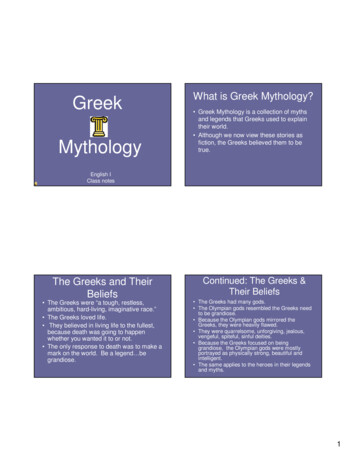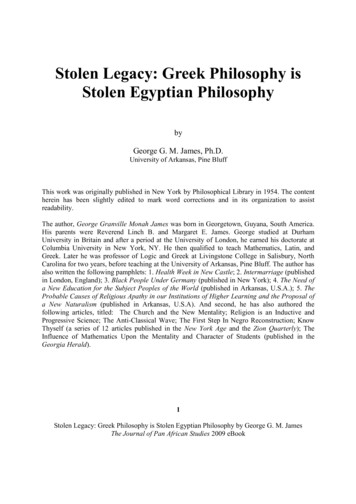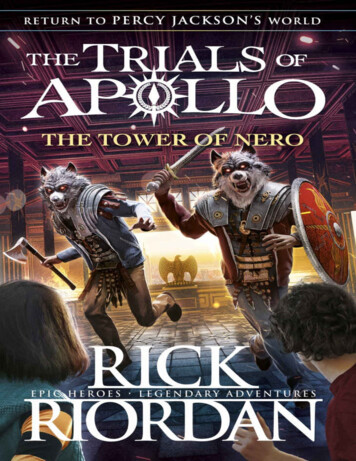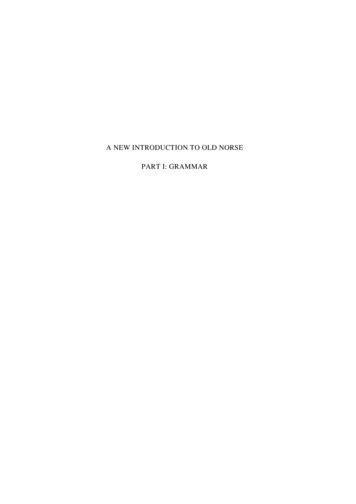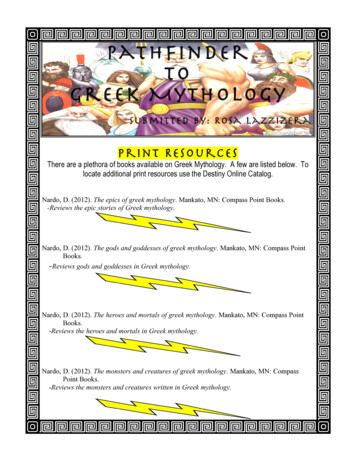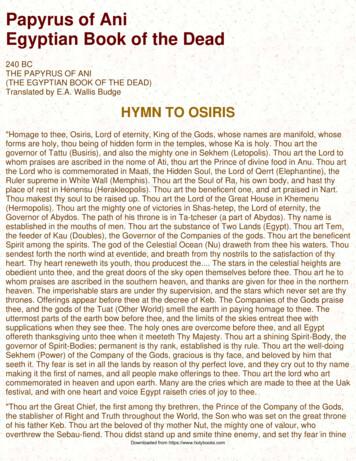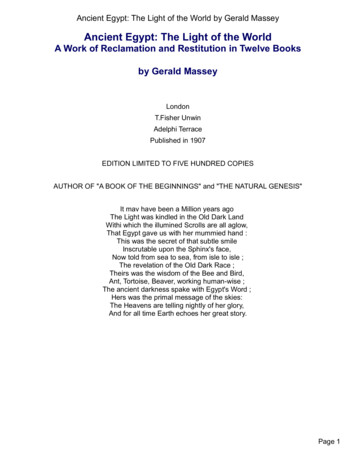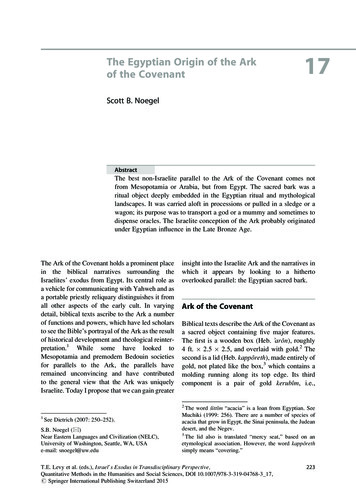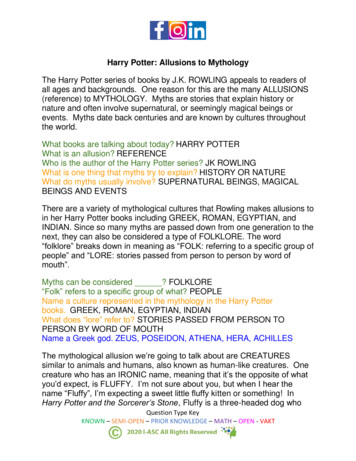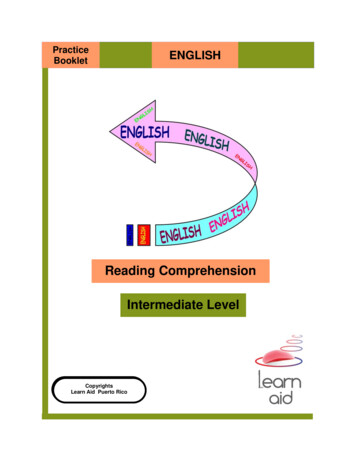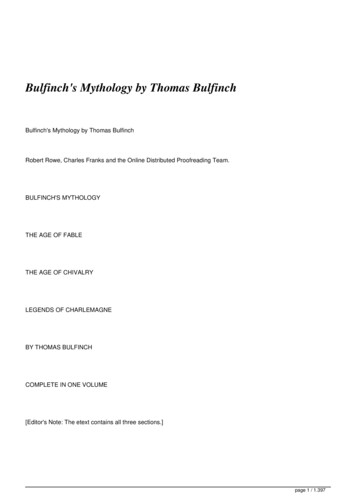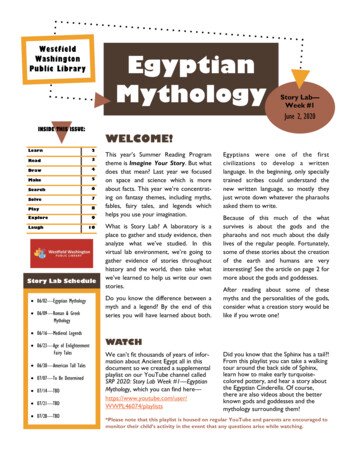
Transcription
WestfieldWashingtonPublic LibraryEgyptianMythologyStory Lab—Week #1June 2, 2020INSIDE THIS ay8Explore9Laugh10Story Lab Schedule 06/02—Egyptian Mythology 06/09—Roman & GreekMythologyThis year’s Summer Reading Programtheme is Imagine Your Story. But whatdoes that mean? Last year we focusedon space and science which is moreabout facts. This year we’re concentrating on fantasy themes, including myths,fables, fairy tales, and legends whichhelps you use your imagination.What is Story Lab? A laboratory is aplace to gather and study evidence, thenanalyze what we’ve studied. In thisvirtual lab environment, we’re going togather evidence of stories throughouthistory and the world, then take whatwe’ve learned to help us write our ownstories.Do you know the difference between amyth and a legend? By the end of thisseries you will have learned about both.Egyptians were one of the firstcivilizations to develop a writtenlanguage. In the beginning, only speciallytrained scribes could understand thenew written language, so mostly theyjust wrote down whatever the pharaohsasked them to write.Because of this much of the whatsurvives is about the gods and thepharaohs and not much about the dailylives of the regular people. Fortunately,some of these stories about the creationof the earth and humans are veryinteresting! See the article on page 2 formore about the gods and goddesses.After reading about some of thesemyths and the personalities of the gods,consider what a creation story would belike if you wrote one! 06/16—Medieval Legends 06/23—Age of EnlightenmentFairy Tales 06/30—American Tall Tales 07/07—To Be Determined 07/14—TBD 07/21—TBD 07/28—TBDWATCHWe can’t fit thousands of years of information about Ancient Egypt all in thisdocument so we created a supplementalplaylist on our YouTube channel calledSRP 2020: Story Lab Week #1—EgyptianMythology, which you can find listsDid you know that the Sphinx has a tail?!From this playlist you can take a walkingtour around the back side of Sphinx,learn how to make early turquoisecolored pottery, and hear a story aboutthe Egyptian Cinderella. Of course,there are also videos about the betterknown gods and goddesses and themythology surrounding them!*Please note that this playlist is housed on regular YouTube and parents are encouraged tomonitor their child’s activity in the event that any questions arise while watching.
What’s special about myths?LEARNCan you guess how many gods andgoddesses the ancient Egyptiansbelieved in? Well your guess is asgood as anyone else's!Hundreds of deities, another wordfor gods and goddesses, wereknown by name but many otherswere not. Also, the kings of ancientEgypt, who were known as pharaohs, were considered gods by thepeople they ruled. The governmentand religion were tied together,and as the leader of the government, the Pharaoh was also leaderof the religion.Some gods looked human butothers took the form of animals.There were even gods who were acombination of human and animal.Some of these gods’ powers wereused to explain natural occurrencesthat people didn’t understandbecause they hadn’t learned aboutscience yet.Page 2Let’s look at a couple of themost prominent gods.In the beginning there wasnothing (Nun). A mound of earthrose from Nun and upon itAtum created himself. Hespat Shu (air) and Tefnut(moisture) from his mouth. Henamed Shu as “life” and Tefnut as“order” and entwined themtogether. Shu and Tefnut gavebirth to Geb (the earth) and Nut(the sky) who in turn give birth toOsiris, Isis, Set, Nephthys andHorus the Elder.Osiris was considered to be theking of the underworld. Anubis, sonof Osiris, was the god of the deadand helped usher them to theunderworld.Isis is known as the Mother ofGods, and is portrayed as a selfless,giving mother and protectress, whoMyths are traditional stories,especially ones concerning theearly history of a people orexplaining some natural or socialphenomenon, especially beforescience and typicallyinvolving supernatural beings orevents. The main characters inmyths are usually gods, demigods or supernatural humans!places other's interests and wellbeing ahead of her own.Keep in mind that these mythsvaried based on where and whenyou lived in Ancient Egypt. Formore information about Egyptiansgods and goddesses, check outsome nonfiction books from thelibrary or visit this website—https://kids.kiddle.co/List of Egyptian gods and goddessesEGYPTIAN MYTHOLOGY
Page 3S T O R Y L AB — W E E K #1READEarly Chapter Fiction Books Magic Tree House: Mummies inthe Morning by Mary Pope Osborne Physical book—Evergreen eBook—Libby A to Z Mysteries: The MissingMummy by Ron Roy Physical book—Evergreen eBook—Libby The Curse of King Tut’s Mummy byKathleen Zoehfeld Physical book—Evergreen eBook—Libby Time Warp Trio: Tut, Tut by JonScieszka Physical book—EvergreenFiction Books The Kane Chronicles: The RedPyramid by Rick Riordan Physical book—Evergreen eBook—Libby Theodosia Throckmartin Series:Theodosia and the Serpents ofChaos by Robin LaFevers Physical book—Evergreen eBook—Libby Goosebumps: Curse of theMummy’s Tomb by R.L. Stine Physical book—Evergreen eBook—Libby Audiobook—HooplaNon-Fiction BooksPro Tip: non-fiction books aboutAncient Egypt are found under thenumber 932. Books about ModernEgypt are found under 962. ForMummies, look under 393! If I Were a Kid in Ancient Egypt Physical book—Evergreen eBook—Libby DK Findout! Ancient Egypt Physical book—Evergreen eBook—Libby Mummies and Pyramids(companion to Mummies inthe Morning) Physical book—Evergreen eBook—Libby
DRAWImage taken from the book How to Draw Egypt’s Sights and Symbols by Betsy Dru Tecco. For more, findthis book in our catalog 0326031Page 4EGYPTIAN MYTHOLOGY
Page 5S T O R Y L AB — W E E K #1LEARNEgyptians began mummifying theirdead nearly 5,00 years ago. At first,only pharaohs were mummified. Intime, the pharaohs’ wives, children,relatives, officials, priests, and servants were also mummified so theycould join the pharaohs in the afterlife.In order to live for all eternity andbe presented in front of Osiris, thegod of the afterlife, the body of thedeceased had to be preserved bymummification, so that the soulcould reunite with it, and takepleasure in the afterlife.The main process of mummificationwas preserving the body by dehydrating it using natron, a naturalmaterial found in the desert whichis like a combination of baking sodaand salt. The body was drained ofany liquids and left with the skin,hair and muscles preserved. Incantations, a series of words said as amagic spell or charm, were saidover the mummy to turn it into animmortal being.The first step was to remove theinternal organs and liquid so thatthe body would not decay. Theembalmers took out the brain anddiscarded it because they thoughtthat the heart did all the thinking.The lungs, liver, stomach, and intestines were removed and placedin canopic jars with lids shaped likethe heads of the protective deities,the four sons of Horus: Imsety,Hapy, Duamutef, and Qebhseneuf.There was no jar for the heartbecause the Egyptians believed it tobe the seat of the soul, and so itwas left inside the body.After the organs were removed,the body was washed inside andout with wine. The embalmers thenstuffed the body with cotton andlaid it on a bed of salt. The bodywas left for 40 days to dry. Whenthe body was dried, the embalmersrubbed the body with perfumes andoils. Before being put in the coffinthe body was wrapped in manylayers of linen bandages whichcould take weeks to complete!MAKEMake your own mummy.What's happening?If you've had enough of apple piesand apple crumble, how aboutmummifying an apple?You should see that one of your apple slices has rotted. Theslice covered in the salt and baking soda mixture hasn't rotted.It's been mummified!What you need:Salt and baking soda are desiccants. Desiccants remove waterfrom any material it comes into contact with. Bacteria thatcause rotting and decay need water to survive. Salt and bakingsoda remove the water from the apple, which makes it hard forbacteria to survive and cause decay.AppleKnife1/3 cup (40 grams) baking soda2/3 cup (80 grams) table saltTwo plastic cupsHow to:1.Cut the apple in half. Eat half!2.Cut the remaining half in half again. Put each piece of appleinto a separate cup.3.Mix together the baking soda and salt. Pour this on top ofone of the apple slices. Make sure the apple is completelycovered.4.Put the cups somewhere out of direct sunlight for oneweek.5.After a week, pour the salt and baking soda mixture out ofthe cup. What has happened to the apple slices? Is there adifference between them?Ancient Egyptians use a similar method to preserve humanbodies after death. They used natron, a naturally occurringdesiccant, to mummify bodies.You could make anapple mummy head!Draw a picture on anapple with felt tips orDon’t forget to sign up for themarker pens. Cover theSummer Reading Program!apple completely with abaking soda and saltwwpl.beanstack.orgmixture and leave for aweek. When you pouraway the baking sodaand salt mixture you'releft with your very own apple mummy head!Remember that the mummy apple is not edible!For a video tutorial, visit our YouTube Channel and check out the SRP 2020: Story Lab Week #1 playlist!
SEARCHSearching the catalog can sometimesfeel like finding a camel in a sandstorm,but it shouldn’t! One good place tostart is the Advanced Search screen.If you’re looking for books aboutAncient Egypt this week, you can tryusing different Keywords such as,Egypt, mummy, pyramid, camel,pharaoh, etc.You can also use the Audience field tolimit the results to books written forchildren.You can use the Literary Form field tochoose between “fiction” which aremade up stories, or “nonfiction” whichare books that contain facts.The Search Library field lets youswitch between “Evergreen Indiana”which is a system of 100 around thestate and “Westfield Washington PL—Westfield” which only includes items inour building.If you select “Westfield WashingtonPL—Westfield” as your search libraryyou’ll also be able to see all of ourShelving Locations. This is helpful ifyou just want to limit your results to“Children’s Picture Book Collection”or our “Award Winning Book Collection.”If you’re in a hurry and want to seewhat we have on the shelf right now,you can check the box to Limit toAvailable.If you need helplocating items inthe catalog orplacing holds onitems, call us at317-896-9391 forassistance!EXPLOREHave you ever seen the insideof a Pharaoh’s Tomb? Wellnow you can, without evenleaving your house!To explore the tomb ofPharaoh Ramesees VI, visitthis website—https://bit.ly/2kLfhJDDon’t forget to look up!You can also read more aboutthe history and architecture ofthe tomb here—https://en.wikipedia.org/wiki/KV9Page 6EGYPTIAN MYTHOLOGY
Page 7S T O R Y L AB — W E E K #1SOLVEThis Kriss-Kross puzzle is all about Egypt – combine logical thinking with literacy, history and art.Solve the puzzle, color the pictures, find out who or what all the words refer to. Fit all the wordslisted in to the grid (in capital letters). If there is only one word of any length there’s only oneplace it can go. Look for clues in the letters you have filled in. You can also visit this puzzles/egyptian-kriss-kross/ — find versions of thepuzzle that you can do on your computer (either in a pdf viewer or in a spreadsheet).The solution to this puzzle is also available at the above website.Cats were considered sacredin Ancient Egypt!Mafdet was the first known cat-headed deity, depicted with a head of aleopard, in ancient Egypt. She was regarded as protector of the Pharaoh'schambers against snakes, scorpions and evil.
SCRIBECan’t read hieroglyphics? Neither could most ancientEgyptians! People trained for years to read and write thecomplicated language of over 700 pictures and shapes!Egyptians were one of the first civilizations to develop awritten language. When archeologists first studied Egyptian hieroglyphics they thought that each symbol represented a word. However, it turns out that the writing ismore complex than that. A symbol can represent aword, a sound, a syllable, or a concept. In some cases,the symbol represents a full word. These symbols arecalled ideograms or logograms. For example, a symbol ofthe woman simply means the word "woman." The samewith a symbol of a man. Some symbols may representmore than one word depending on the context of howthey are used and the other symbols around them. Thesame symbol used for "sun" can also mean "light."In the picture to the right, we've shown some comparisons of symbols and how they might relate to our alphabet. You will note that there are cases where two different symbols have the same sound (see the letter "Y" atthe bottom). This is just like we have when some of ourletters can make the same sound depending on the word(for example "c" and "k").Can you write your name in hieroglyphsusing the chart of symbols to the right?PLAYPage 8Despite early beliefs that regular peopleonly slaved away building the pyramidsand didn’t have any leisure time, thatturns out not to be true! An ancientstela, an upright stone slab or columnwith carved commemorative inscriptions, describes numerous sportingevents staged by the nobles.Ancient Egyptian children of both upperand lower classes tended to have thesame kind of toys, although the upperclass children had fancier versions.Children played with many of the sametypes of toys that modern children do,including dolls, puppets, balls, andboard games.What kind of events did this steladescribe? The upper classes usuallyparticipated in more formal eventssuch as archery shooting competitionsand large-scale boat races. The lowerclasses usually pursued less formalactivities such as simple ball gamesand physical contests like tug-of-warand wrestling.Two board games that werepopular were called Senet andMehen. Gameplay in both aresimilar—pieces, usually stones,move along the board based onhow the different colored stickslanded after being thrown, asdice hadn’t been invented yet.However, the shape of theboards differ; Senet uses a rectangleboard but Mehen uses a round board.You can download instructions andyour own game board for 1429015449 Egyptian Game Mehen.pdfEGYPTIAN MYTHOLOGY
Page 9S T O R Y L AB — W E E K #1EXPLOREThe Great Pyramids of Giza are the onlysurviving seven wonders of the ancientworld and one of the most recognizableman-mad structures on the planet! Manyother features of ancient Egyptian architecture have stood the test of time andhave been copied for thousands of years.There have even been architects whowere influenced by the Egyptians, thousands of years later and half way aroundthe world, right here in Indiana! Three famous buildings in theIndianapolis area show distinct designfeatures first used by the Egyptians: The Old National Centre, asocial venue formerly known asthe Murat Shrine TempleThe OldNationalCenterwas builtin theearly1900s bytheShriners,a socialorganization. It ismostlyknown for its theater which featuredBroadway shows, visiting dignitaries, andmusical concerts. One of the event venues inside is called the Egyptian Room!You can take a virtual tour of oldnationalcentre/The Veterans War Memorialobelisk fountainThe obelisk inVeteransMemorialPlaza wasconstructed aspart of aproject thatstarted in the1920s. Anobelisk is astone pillar,typically havinga square orrectangularcross sectionand a pyramidal top, set up as a monument orlandmark. Another famous obeliskthat you might recognize is theWashington Monument inWashington D.C. The Pyramids, an officecomplex on the northwest sideDesigned for an insurance companyand originally completed in 1967,these pyramids are much moremodern than their ancient counterparts in Egypt. Each of the threebuildings has four sides, but insteadof being made of solid stone orconcrete, two of the sides on eachbuilding are all glass windows. Theywere originally planning to buildnine pyramids but only three wereever constructed.Can you find tracesof Ancient Egyptin your neighborhood?REFERENCES Arts, Leisure, and Sport in Ancient Egypt by Don Nardo https://www.ancient.eu/ Egyptian Hieroglyphics by Stéphanie Rossini https://kids.kiddle.co/List of Egyptian gods and goddesses Egyptian Myths by Jacqueline Morley & Giovanni Caselli http://www.primaryhomeworkhelp.co.uk/Egypt.html Egyptian Myths by Eric Braun https://egypt.mrdonn.org/ Stories of Mummies and the Living Dead by Eric Kudalis https://www.historyforkids.net/ancient-egypt.html Mummy Riddles by Katy Hall & Lisa Eisenberg / Pyramids: 50 Hands-on Activities by Avery Hart & P. Mantell n-lifeand-culture
LAUGHWhat do you call a mummythat sleeps all day? Lazybones!333 West Hoover StreetWestfield, IN 46074Phone: usWESTFIELD WASHINGTONP U B L I C L I B RA R YFostering exploration, discoveryand growth!Follow us on socialmedia @WWPL46074Where do mummies swim? The Dead Sea!What do mummies like tolisten to? “Wrap” music!What should you do if amummy rolls his eyes atyou? Roll them back!What’s the speed limit inEgypt? 55 Niles an hour!WRITEA story’s setting, or the time and place (or when and where), isoften totally made up by authors of fantasy novels. However,some of these settings are inspired by cultures other cultures,some which no longer exist, like ancient Egypt.Now that you’ve explored Ancient Egypt think about how youcould include elements of their myths and culture into a storyof your own. Would your character live in a desert? Maybe theywould live here but travel back in time to ancient Egypt. Imaginewhat would happen once they gotthere.Maybe the setting of your storycould have special realms like theEgyptian underworld, called Duat,or the primordial watery abyss,called Nun, that existed before thecreation of the gods and humans.What would happen there?Wherever you start, remember touse your imagination!Next WeekBe on the look out for next week’sStory Lab edition which will be available on Tuesday, June 9, 2020.We’ll be focusing on Roman andGreek Mythology.
Mythology June 2, 2020 Story Lab— Week #1 Westfield Washington Public Library Story Lab Schedule 06/02—Egyptian Mythology 06/09—Roman & Greek Mythology 06/16—Medieval Legends 06/23—Age of Enlightenment Fairy Tales 06/30—American Tall Tales 07/07—To Be Determined 07/14—TBD 07/21—TBD
